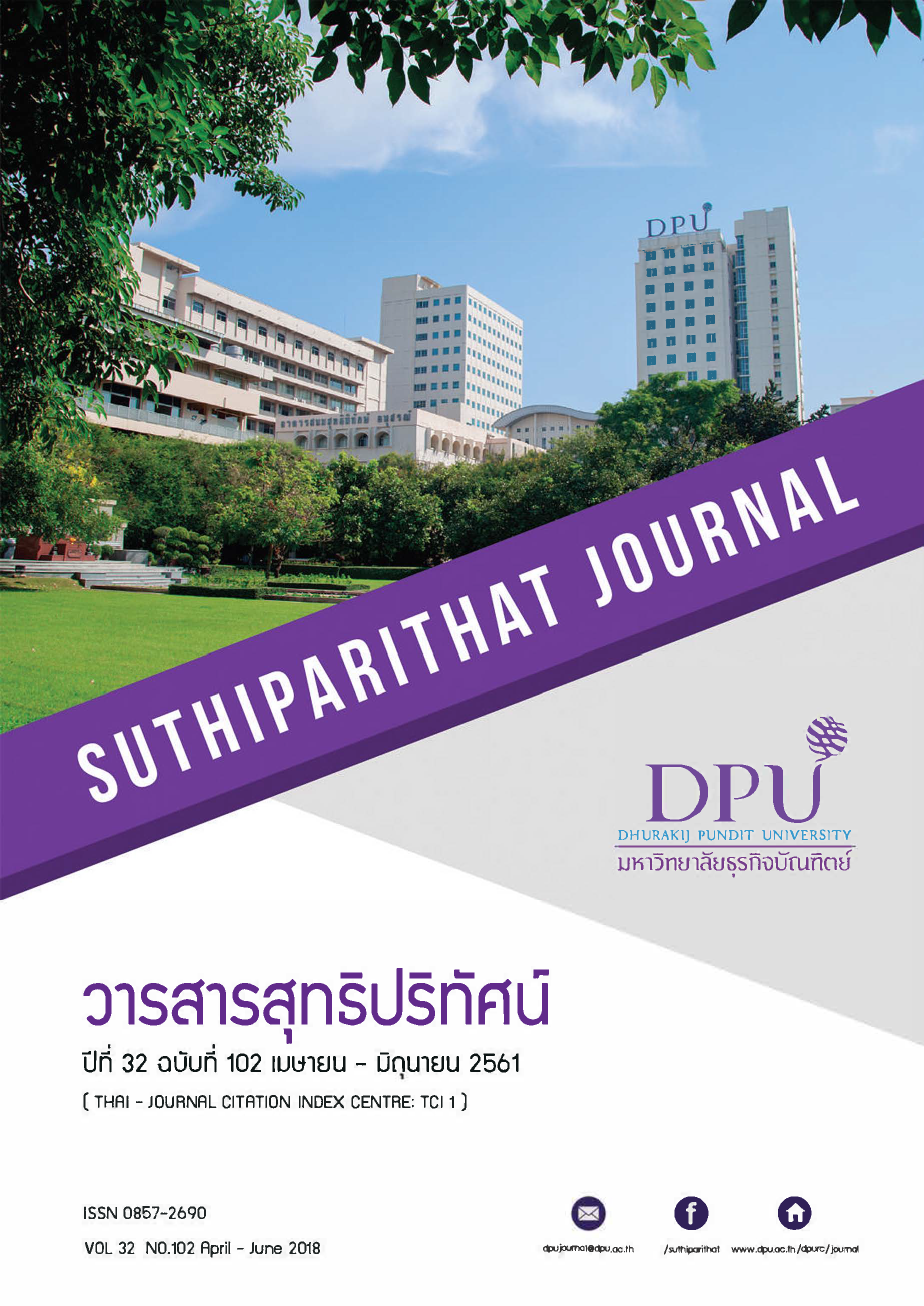ศักยภาพการแข่งขันของคลัสเตอร์อุตสาหกรรมเกษตรแปรรูปจังหวัดศรีสะเกษ
คำสำคัญ:
ศักยภาพการแข่งขัน, คลัสเตอร์, ทฤษฏีระบบเพชร, อุตสาหกรรมเกษตรแปรรูปบทคัดย่อ
การศึกษาวิจัยนี้มีวัตถุประสงค์เพื่อประเมินศักยภาพการแข่งขันและเพื่อเสนอแนวทางในการ เพิ่มศักยภาพในการแข่งขันของคลัสเตอร์อุตสาหกรรมเกษตรแปรรูป จังหวัดศรีสะเกษ โดยกลุ่มตัวอย่าง ได้แก่ วิสาหกิจขนาดกลางและขนาดย่อมที่รวมกลุ่มกันเป็นเครือข่ายคลัสเตอร์อุตสาหกรรมเกษตรแปรรูป ประกอบด้วยอุตสาหกรรมต้นน้ำ ได้แก่เกษตรกรผู้เพาะปลูก กลางน้ำ ได้แก่ ผู้แปรรูปผลิตภัณฑ์จาก สินค้าเกษตร และปลายน้ำ ได้แก่ ผู้ค้าและจัดจำหน่าย ประเภทหอม กระเทียม พริก และเห็ดจำนวน 28 ราย เครื่องมือที่ใช้ในการประเมินได้พัฒนาจากทฤษฏีระบบเพชรของ Michael E. Porter และ โมเดล เก้าปัจจัย (Nine-factor model) โมเดลรูปกรวย (Funnel model) และโมเดลการแข่งขันที่บรรลุเป้าหมาย และดำรงอยู่ได้อย่างยั่งยืน (Destination competitiveness and sustainability model) โดยกำหนดคะแนน ประเมิน 4 ระดับ ผลการวิจัยพบว่า ในภาพรวมศักยภาพในการแข่งขันของอุตสาหกรรมคลัสเตอร์เกษตร แปรรูป จังหวัดศรีสะเกษอยู่ในระดับค่อนข้างสูง 2.88 คะแนน คิดเป็นร้อยละ 73.26 โดยมีศักยภาพด้าน สถานะอุปสงค์อยู่ในระดับสูง 3.23 คิดเป็นร้อยละ 80.63 เมื่อเทียบกับศักยภาพด้านกลยุทธ์ โครงสร้าง และสภาพการแข่งขันของธุรกิจด้านสถานะปัจจัยการผลิต ด้านโอกาส ด้านรัฐบาลและด้านอุตสาหกรรม ที่เกี่ยวเนื่องและสนับสนุนที่อยู่ในระดับค่อนข้างสูง โดยมีคะแนนที่ 2.98 คะแนนหรือร้อยละ 74.38, 2.92 หรือร้อยละ 73, 2.85 หรือร้อยละ 71.25, 2.66 หรือร้อยละ 66.46, 2.65 หรือร้อยละ 66.25 ตามลำดับ
เอกสารอ้างอิง
สำนักงานคณะกรรมการส่งเสริมการลงทุน. (2558). อนาคตไทยก้าวไกลด้วยคลัสเตอร์. สืบค้น 22 กันยายน 2560 จาก http://chonburi.boi.go.th/public/upload/center_4/file/BOI-brochure-cluster%20area-TH-20151116.pdf
สำนักงานจังหวัดศรีสะเกษ. (2558). ข้อมูลสภาพทั่วไปของจังหวัดศรีสะเกษจังหวัดศรีสะเกษ. สืบค้น 22 กันยายน 2560 จาก http://www.sisaket.go.th/story_sisaket/vission_goverment.php
Benito, G. B. (2003). A Cluster analysis of the maritime sector in Norway. International Journal of Transport Management, 1(4), 203-215
Biuksane, I. (2016). Model of the Factors Influencing Competitiveness of the Latvian Fisheries Sector Cluster. Economic and Business, 28(1), 76-82.
Boja, C. (2011). Clusters Models, Factors and Characteristics. Journal of Economic Practices and Theories, 1(1), 34-43.
Didziokas, R. V. (2014). Cluster Models,Factors and Characteristics for the Competitive Advantage of Lithuanian Maritime Sector. Economics and Management, 19(2), 162-171.
Krugman, P. (1991). Geography and trae. London: MIT Press/Leuven UP.
Kuah, A. T. (2002). Cluster Theory and Practice: Advantages for the Small Business Locating in a Vibrant Cluster. Jounal of Research in Marketing and Entrepreneurship, 4(3), 206-228.
Porter, M. E. (1990). The Competitive Advantage of Nations. London: Macmillan.
Porter, M. E. (2000). Location Competition, and Economic Development: Local Cluster in a Global Economy. Economic Development Quarterly,14(1), 15-20.
Ritchie, J. R.and Crouch I.G. (2010). A model of destination competitiveness/sustainability: Brazilian Perspectives. Revista de Administracao Publica, 44(5), 1049-1066.
Solvell, O. (2008). Clusters, Balancing Evolutionary and Constructive Forces. Stockholm, Sweden: Ivory Tower Publishing.
Sung, D. Cho. (1994). A Dynamics Approach to International Competitiveness: The Case of Korea. Journal of Far Eastern Business. 1(1),17-36
Viederyte, R and Didziokas, R. (2014) Cluster Models, Factors and Characteristics for the Competitive Advantage of Lithuanian Maritime Sector. Economics and Management, 19(2), 162-171
ดาวน์โหลด
เผยแพร่แล้ว
รูปแบบการอ้างอิง
ฉบับ
ประเภทบทความ
สัญญาอนุญาต
เนื้อหาและข้อมูลในบทความที่ลงตีพิมพ์ในวารสารสุทธิปริทัศน์ ถือเป็นข้อคิดเห็นและความรับผิดชอบของผู้เขียนบทความโดยตรงซึ่งกองบรรณาธิการวารสาร ไม่จำเป็นต้องเห็นด้วย หรือร่วมรับผิดชอบใด ๆ
บทความ ข้อมูล เนื้อหา รูปภาพ ฯลฯ ที่ได้รับการตีพิมพ์ในวารสารสุทธิปริทัศน์ ถือเป็นลิขสิทธิ์ของวารสารสุทธิปริทัศน์หากบุคคลหรือหน่วยงานใดต้องการนำทั้งหมดหรือส่วนหนึ่งส่วนใดไปเผยแพร่ต่อหรือเพื่อกระทำการใด ๆ จะต้องได้รับอนุญาตเป็นลายลักษณ์อักษรจากวารสารสุทธิปริทัศน์ก่อนเท่านั้น







